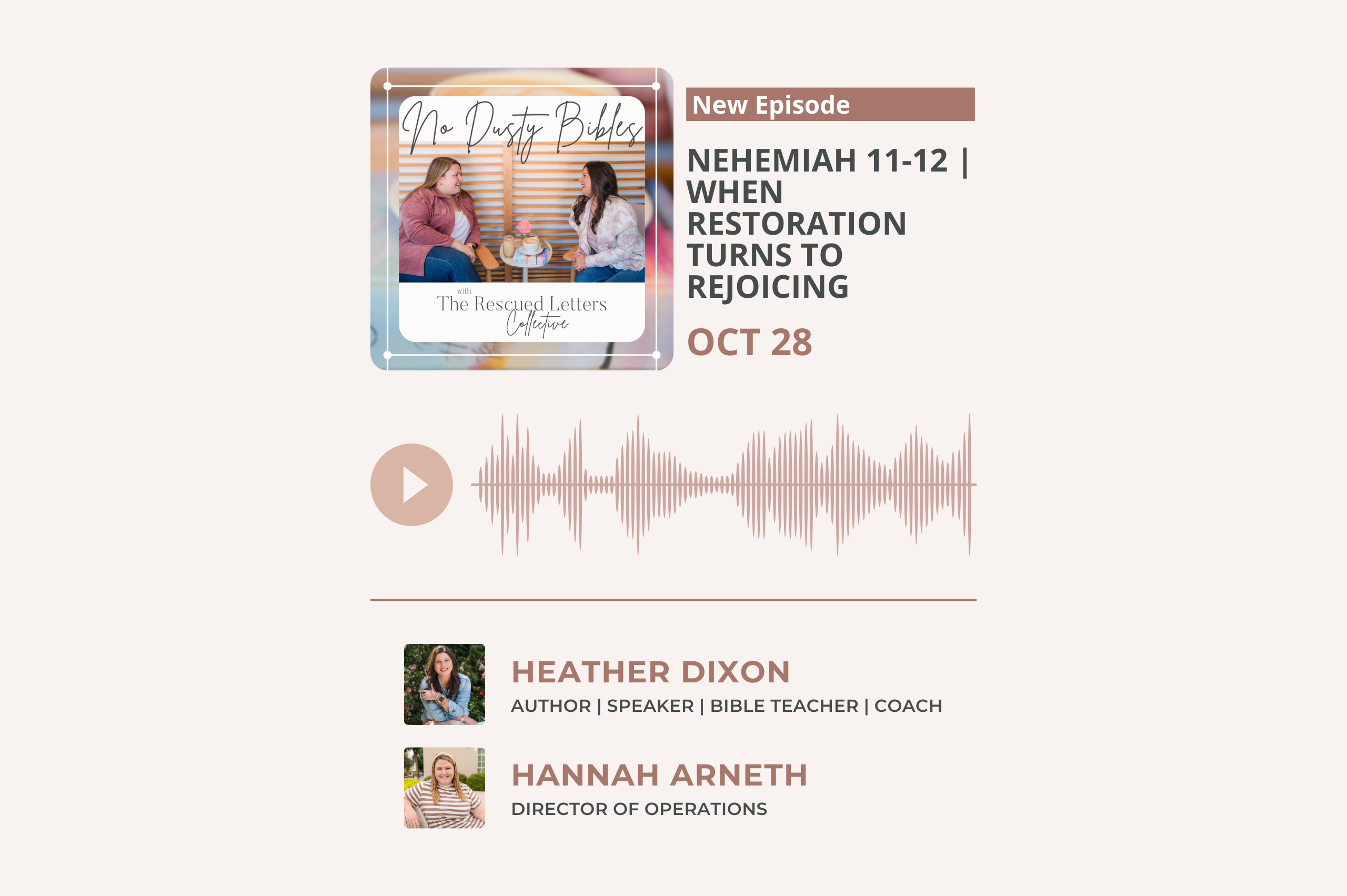When you think about the New Testament, one name probably comes to mind: Paul. He’s the guy behind many of the letters we read, but who was he really, and why should we care about what he wrote? If you’re diving into Paul’s letters with us on the No Dusty Bibles podcast, or just reading them on your own, here are 10 things to keep in mind that will help you get the most out of his letters to the early church.
1 – Who was Paul?
Before he was the Apostle Paul, he was Saul of Tarsus, a Pharisee who was passionate about upholding Jewish law—so passionate, in fact, that he persecuted early Christians. But then, in one of the most dramatic conversion stories ever (Acts 9), Paul encountered Jesus on the road to Damascus, and his life was flipped upside down (in the best possible way). From that moment on, Paul became one of the most zealous advocates for the very faith he once tried to destroy.
Why does this matter? Because it shows us that Paul wasn’t just some random guy writing letters. He was someone who experienced a radical transformation at the hand of the Holy Spirit, and his writings are filled with the passion and urgency that come from someone who knows the power of God firsthand.
2 – Paul’s Mission
Paul wasn’t content with keeping the good news to himself or within his Jewish community. He believed that the message of Jesus was for everyone, and he dedicated his life to spreading it to the Gentiles—basically, anyone who wasn’t Jewish. Paul traveled extensively, planting churches and mentoring new believers. His mission was clear: to make disciples of all nations, just as Jesus commanded.
When reading Paul’s letters, it’s important to remember that he was writing to real people in real places, often addressing specific issues they were facing. Whether it was dealing with false teachers, encouraging unity, or giving instructions on Christian living, Paul’s letters were meant to guide and build up these early communities of faith.
3 – Context Matters
Have you ever read something and thought, “I have no idea what’s going on here”? Understanding the context of Paul’s letters can help with that. Paul wrote in the first century, a time when the Roman Empire ruled much of the known world. The people he was writing to were navigating a culture that was often hostile to their new faith. They were figuring out how to follow Jesus in a world that didn’t understand Him—and that sometimes actively opposed Him.
Understanding the historical and cultural backdrop of these letters can help us make sense of some of Paul’s more challenging passages. It also helps us see just how relevant his writings still are today, as we navigate our own culture with its own set of challenges.
4 – Theological Depth
Paul wasn’t just writing to say hello and offer a few tips for daily living. His letters are rich with theological truths that have shaped Christian doctrine for centuries. Themes like grace, justification by faith, the role of the Old Testament law, and the significance of Christ’s death and resurrection are all central to Paul’s writings.
But here’s the thing: Paul didn’t write his letters as academic treatises. He was a pastor at heart, deeply concerned with the spiritual well-being of his readers. So when you’re reading his letters, don’t just skim over the theological parts. Take your time with them, ask questions, and let them deepen your understanding of God’s incredible plan for humanity.
5 – Paul’s Writing Style
If you’ve ever read through one of Paul’s letters and thought, “Wow, this is intense,” you’re not alone! Paul had a unique way of writing that was deeply personal, sometimes confrontational, and always passionate. Most of his letters follow a basic structure: he starts with a greeting, moves into a thanksgiving or prayer, dives into the main body where he addresses specific issues, and then closes with some final exhortations and a benediction.
Paul also loved using rhetorical techniques like asking questions, drawing contrasts, and building up to a powerful conclusion. When reading his letters, pay attention to these techniques—they can help you follow his train of thought and grasp the significance of what he’s saying.
6 – A Christ-Centered Focus
One thing you’ll notice when reading Paul’s letters is that they are all about Jesus. Paul didn’t just see Jesus as a great teacher or a moral example; he saw Him as the Son of God, the Savior of the world, and the one in whom all things hold together (Colossians 1:17). Paul’s entire life and ministry were centered on the life, death, and resurrection of Jesus, and he wanted his readers to have that same focus.
Whether Paul was talking about how to live as a Christian, how to relate to others, or what to expect in the future, Jesus was always at the center. So as you read, keep asking yourself, “How does this point me back to Christ?”
7 – Practical Application for Today
Paul wasn’t just interested in filling people’s heads with knowledge; he wanted them to live out their faith in practical, everyday ways. His letters are filled with instructions on how to live as a follower of Jesus—how to love others, how to deal with sin, how to serve the church, and how to endure trials.
But Paul didn’t just give out commands. He also gave encouragement, reminding his readers that they were not alone in their struggles and that God was at work in their lives. As you read, look for ways you can apply Paul’s teachings to your own life. What is God calling you to do? How can you grow in your walk with Him?
8 – Unity & Diversity in the Body of Christ
One of Paul’s key concerns was the unity of the church. In a world where people were divided by ethnicity, social status, and religious background, Paul preached a message of unity in Christ. He believed that in Christ, there is neither Jew nor Greek, slave nor free, male nor female (Galatians 3:28)—all are one in Him.
But Paul also recognized and celebrated diversity within the body of Christ. He wrote about different spiritual gifts, different roles within the church, and the importance of each member of the body working together for the common good. As you read Paul’s letters, reflect on how you can contribute to the unity and health of your own church community.
9 – Paul’s Kingdom Perspective
Paul was always looking ahead to the future, to the day when Christ would return and set all things right. His letters are filled with hope and anticipation for the coming Kingdom of God. But Paul didn’t just focus on the future; he believed that this future hope should impact how we live now.
Paul’s letters encourage us to live with a Kingdom perspective, to set our minds on things above, and to let the hope of Christ’s return shape our values, decisions, and actions. As you read, let this Kingdom perspective challenge you to live with purpose and passion.
10 – Our Hope & Future Glory in Christ
Finally, Paul’s letters are a constant reminder of the hope we have in Christ. Even in the midst of suffering and hardship, Paul never lost sight of the future glory that awaits those who belong to Jesus. He encourages us to persevere, to run our race of faith with endurance, and to fix our eyes on Jesus, the author, and perfecter of our faith.
As you read Paul’s letters, let his words of hope and encouragement lift your spirits and strengthen your resolve. Remember that the struggles of this life are temporary, but the glory that awaits us is eternal.

Paul’s letters are some of the most powerful and influential writings in the New Testament. They’re filled with deep theology, practical advice, and a passion for Christ that is contagious. As you read through these letters, keep these 10 things in mind—they’ll help you not only understand what Paul was saying but also how it applies to your life today.
So grab your Bible, a journal, and maybe a cup of coffee, and let’s dig into Paul’s letters together. There’s so much to discover, and I’m so thankful you are here journeying with me!
This post contains affiliate links, which means that at no additional cost to you, I may receive a small commission if you click on and/or purchase from one of the product links. Affiliate links help to "keep the lights on" at The Rescued Letters and I only recommend products that I personally use or are from companies that I know and trust. I really appreciate your support in this way. You can read my full disclosure policy here.
Additional Resources
If you’re looking for more resources to deepen your understanding of Paul’s letters, here are a few recommendations:
- Books: Paul: A Biography by N.T. Wright and Paul: Apostle of the Heart Set Free by F.F. Bruce.
- Study Guides: Check out the New Testament for Everyone series by N.T. Wright (this link is to the complete 18-volume set, but they can be purchased individually) or the LifeChange series on Paul’s letters (I’ve linked to the study guide on Romans here, but there are guides available for all of Paul’s letters.)
- Podcasts: Don’t forget to tune in to the No Dusty Bibles podcast, where we’re reading through the entire Bible!
I hope this post has given you a new perspective on Paul’s letters and inspired you to dive deeper into God’s Word. Let’s keep our Bibles open, our hearts soft, and our minds engaged as we explore the Word of God together.
I’m rooting for you. Always.
Heather







